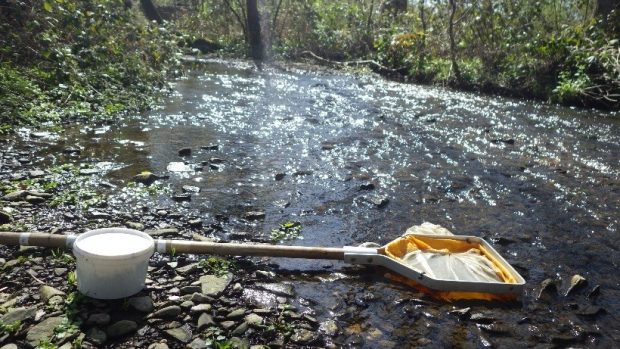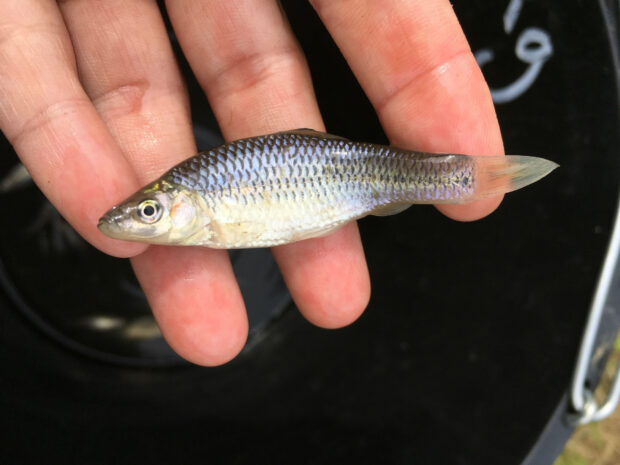
I am a Naomi Diver and a freshwater ecologist otherwise known as an Environmental Monitoring Officer based in the East Midlands. I love my job! Who knew when I was river dipping as a kid that I would end up looking at bugs for a job.
My work involves using chemical samples and what lives in rivers (plants, invertebrates, algae & fish) to assess water quality and quantity issues. I am regularly out in my waders knee deep in a river collecting invertebrate kick samples, assessing in stream habitats or undertaking fish, macrophyte or algae surveys. In my role I come across many examples of the detrimental impact invasive species have on our rivers. Invasive species can be harmful in a number of ways: by spreading diseases, outcompeting/preying on native species, preventing the recreational use of waterways, damaging habitats and flood defences, causing a decrease in water quality and they can even harm human health. Once established, invasive species can be pervasive and almost impossible to eradicate. There are many non-native invasive species already present in the UK and many more threatening to arrive. I must undertake field work in a biosecure way to protect the wonderful native habitats, ecology and environments we have here in the UK.
For example, if I am collecting invertebrate samples I stay within one catchment, preventing the spread between water catchments that are not naturally linked. I also start at the most upstream point and work downstream. The nature of the East Midlands means that most invasive species are found in the Trent possibly arriving by the shipping lanes by the Humber. This means that aquatic invasive species are most likely to be present in the downstream part of the catchment. By starting at the most upstream point I am protecting the ecology found there and the most risky sites are the last visited in the day. I take multiple sets of equipment where possible such as nets, so I can use a clean net at each site. Waders and equipment are visually checked after being on each site and sprayed down with a disinfectant called Virkon. This helps prevent the spread of crayfish plague carried by the American signal crayfish which is deadly to our native white clawed crayfish.
I am aware of the location of non-native species in the East Midlands however biosecurity is maintained at all times; you never know what you will find on site, or what you can’t even see such as viruses and diseases. One of the most important things in my role is the ability to recognise invasive species and record any occurrences. I regularly check for new species alerts by the Non-Native Species Secretariat and have aqua invaders/plant tracker apps on my phone. When out in the field if I spot an invasive species I can take a photo on the app and the record will be added to the database.
When I finish a day of fieldwork I head back to the office and unpack everything into a drying room. I check equipment for mud, plant fragments and invertebrates. I clean equipment using hot water which is connected to the foul sewer system. Finally I leave the equipment to dry for 48 hours before being used again. The Check, Clean Dry method is recommended for everyone to prevent the spread of non-native species.
Being aware of invasive species and undertaking my activities in a biosecure way only requires a bit of effort but the reward of protecting the environment is priceless. For more information why not check out the free elearning from the non-native species secretariat.
The Invasive Species Week runs from Friday 23 March to Thursday 29 March. For more information visit the website


2 comments
Comment by vic crowhurst posted on
I would like some more information on how to identify topmouth gudgeon, as I've never heard of this species before.
Comment by steven mccarthy posted on
I found the information very usefull I will deffinatley make sure my wader's or wellie's are cleaned thoroughly when i get back from Ireland we do clean them and leave them out in the sun if poss.And ill keep an eye out for any invasive species thank's